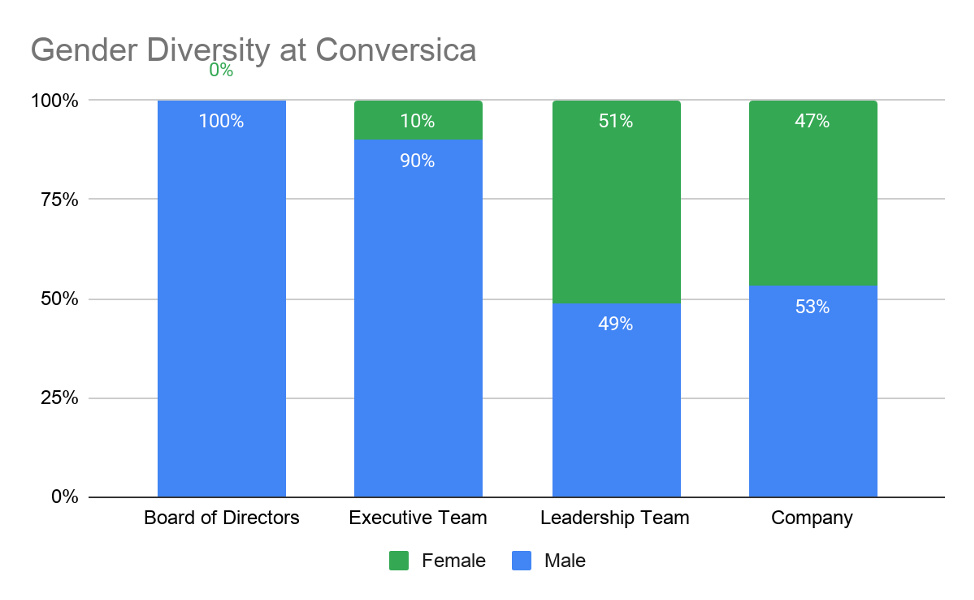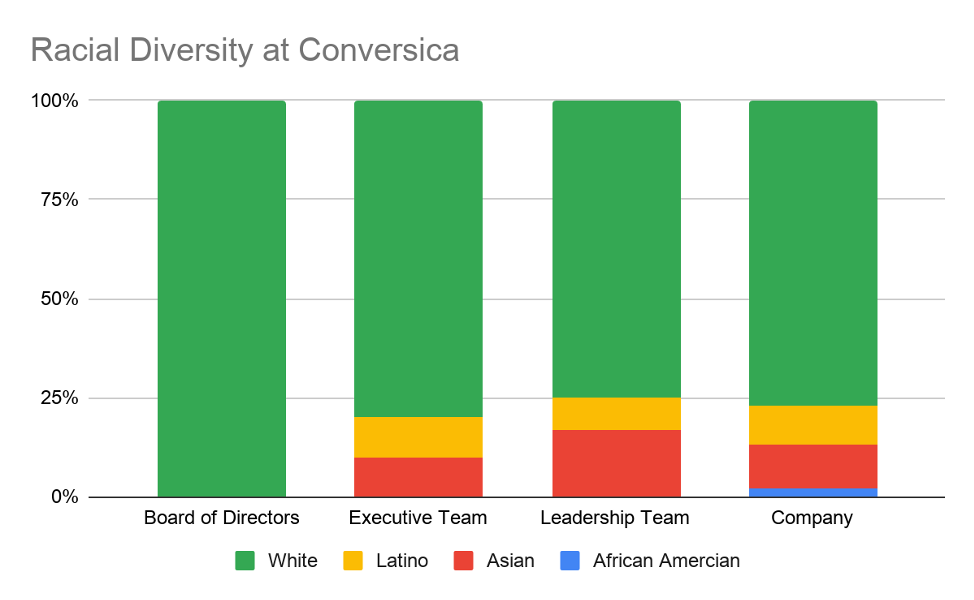Actions Speak Louder Than Words: A Path Forward for Diversity, Inclusion, and Equality in Business
This is a reprint from the Conversica Blog, where I discuss diversity and equality within our company; as well as the catalyst for compassionate change in our culture.
It’s been over 10 tumultuous days across the United States as emotional energy peaks after the private memorial service for George Floyd. It took only 8 minutes, 46 seconds to rob George Floyd, his family and his community of a life that should be valued no differently than any other.
I can’t stop hearing the words, “I can’t breathe.” And as many know, those words were not only George Floyd’s last, but they were voiced by Eric Garner 11 times before he died during a similar event in 2014.
How many brutal, unjust, horrific tragedies have occurred that we’re not aware of? And, equally, if not more importantly, how many more lives will it take before America unites to create the change needed to stop this?
A Catalyst for Change, Real Change
IT’S TIME TO STOP
STOP DISCRIMINATION
STOP INEQUALITY
STOP THE INJUSTICES
I hope these atrocious acts of violence sparks a lasting flame of compassion within our wider culture.
It is imperative that we say their names with great compassion and solidarity: Breonna Taylor, Ahmaud Arbery, Eric Garner, Michael Brown, Trayvon Martin, and George Floyd. And to humbly recognize that there are names that have gone unrecognized and unnoticed, but are nonetheless real and deserving of human dignity.
Let this moment inspire all of us to take action to create permanent change for a more fair society.
Talk Is Weak. Actions Speak Louder Than Words.
At Conversica, we encourage our employees to openly voice their thoughts through an anonymous platform. I have to say, I love their feedback.
Like many of my CEO peers, I sent my staff an email acknowledging the events unfolding, and reinforcing our commitment to company-wide diversity and inclusion.
But it didn’t take long for my staff to challenge me: “Most companies are actively condemning the discrimination and injustice against black people,” but “Will Conversica take a stand against racism?” And then it hit me. Talk is weak. It’s time to act.
Exchanges like these eventually developed. Employees identified themselves and their positions, igniting creative ideas of how we could take action, real action.
It was then that I knew I couldn’t focus on the day-to-day responsibilities and duties. This isn’t a checklist for a few simple improvements to existing diversity programs or just letting the rest of the world lead the charge.
What Are We Doing for Diversity Within Our Own Company?
I can remember my first week at Conversica, being onboarded like every new employee. As the new CEO, I wasn’t just going through the motions. I was studying the culture. One of my first questions was: “What are we doing for diversity?”
If you were to classify me into a “CEO bucket,” I would define my bucket label as “culture CEO.” I believe in “people power.” I strive to ensure that our people realize their full potential to create impact within our organization.
When I get invited into a new company, people are always my immediate focus. And I like to think that I am one of the most sensitive to diversity, inclusion and equality. But I’ve fallen behind. I’ve taken my eye off the diversity ball, especially during COVID. Recent events have magnified the fact that I and my peer CEOs are not doing enough.
So, in an effort of transparency and honesty, here’s our current snapshot of diversity across gender and racial dimensions:
The following gives us the view of Conversica in gender and race across various groups including our Board, our Executive team, our entire Leadership team (all people managers), as well as the company as a whole.
Looking at the next part of our scorecard, it’s clear that our racial diversity is the most challenged across all groups at Conversica.
Sure, when compared to the industry average for other high-tech companies, including leaders in this space like Salesforce or Twitter, we may be doing okay in some areas of company-wide diversity. But for the most part, we’re like all high-growth companies. We still fall short.
What Have We Done to Foster Diversity, Inclusion, and Equality?
For those who know me, I carry a set of playbooks everywhere I go. To foster diversity in organizations, my philosophy is the following:
- Recruit to Your Target Diversity Mix: This means that you tell recruiters (internal and external) that your candidate pool MUST represent the gender and racial mix you want the company to ultimately look like. This helps hiring managers because they only need to hire the best candidate. And statistically, in the steady-state, you will look like your recruiting mix. However, I say this with ONE caveat… leading me to the next point.
- Educate Hiring Managers on Cultural Bias: I always hire my favorite consultant to come in and educate people on natural cultural biases. His name is “Dr. G.” He has multiple psychology degrees and focuses on “Corporate Culture.” You don’t want to put five great candidates in front of someone and they always gravitate towards the 50-year-old white male.
- Establish Formal Diversity and Inclusion Certifications: I run all my leadership teams through formal diversity training certification. But be aware: Not all diversity training is equal. I am personally very big into the personality traits of people. And it’s my belief that people who prefer majority groups dominating minorities within a social hierarchy, tend to be more resistant to diversity training than individuals who are low on this trait. Look into “perspective-taking” diversity training programs (aka role-playing) to help with this.
- Provide Generational Differences Training: I also have a consultative workshop for people managers that runs the team through age discrimination biases – understand the differences between Generation Z/Boomlets, Generation Y/Millennials, Generation X, and Baby Boomers.
- Enforce Equal Pay: Our philosophy around pay practices for all departments is to pay at market based on employee levels, bands and experience. We have an equal pay program which has the goal of making all people — regardless of gender, race, religion, sexual preference, age, etc. — are within five percent of the median within their role.
- Manage Initiatives to Diversity and Inclusion KPIs: Many companies struggle with effectively measuring outcomes of diversity initiatives. The challenge in this stems from determining what metrics should be tracked and what measurements will produce valuable and relevant information. Diversity metrics need to be aligned with key organizational values and goals. These KPIs need to cut across recruiting, training, external awareness, culture, retention, and advancement.
I fully recognize this list only scratches the surface. It falls significantly short of the change needed. So, what’s next for Conversica?
What Can We Do Better?
As a company, we need to understand that diversity runs across culture, race, religion, age, gender, and sexual orientation.
We also need to understand that equality cuts across social, civil, political, economic, opportunity, and educational equalities.
There are so many topics that companies need to support and help their employees proactively address. What about climate change, immigration, homelessness, or sexual violence? Can companies proactively take a stance to help create a real difference across all of these? Absolutely.
It’s easy to talk the talk. But how do we move from words to actions?
From Words to Actions: Our Pledge
As Conversica’s CEO, I commit to turning words into actions starting with the following pledges.
| Pledges | Words to Actions |
| Conversica’s Employee Day for Diversity | This pledge is two-fold. Annually on Martin Luther King Jr. Day—occurring on the third Monday in January—Conversica will set goals for diversity and inclusion within our organization for the year ahead. We will revisit these goals, mid-year, on May 25th, the anniversary of George Floyd’s untimely death. By memorializing this date as “Diversity Day,” we will reflect upon our pledge to support diversity, inclusion and equality; reviewing our progress and publishing them for all. |
| Conversica’s Services for Diversity | Starting immediately, Conversica will provide minority-owned businesses and charities supporting minority advancement with free augmented workforce solutions. |
| Conversica’s Recruiting for Diversity | We will achieve our employee diversity mix targets by 2022 by requiring a diverse selection of candidates for every role. |
| Conversica’s Training for Diversity | Management training on diversity, inclusion, and equality will be provided annually. Maintain zero discrimination complaints/incidents by employees. |
| Conversica’s Community Support for Diversity | Employees will be encouraged to volunteer in external diversity initiatives and be rewarded for their community service. Conversica will sponsor events and webinars to support our continued education and community participation in diversity, inclusion and equality topics. |
| Conversica’s Metrics for Diversity | Report Conversica’s progress on its diversity KPIs to employees, and to the public, ultimately holding ourselves accountable. |
| Conversica’s Retention and Advancement for Diversity | Increase career development for underrepresented group members. We will measure and manage the rate and time of promotions, in addition to retention of employees. |
| Conversica’s Trusted Exchange for Diversity | Empower a trusted environment (e.g. anonymous employee engagement platform, management and employee events) where all ideas are welcomed, and employees feel comfortable and empowered to have discussions about diversity, inclusion, and equality. |
| Conversica’s Ecosystem for Diversity | Enforce our diversity, inclusion, and equality by “firing” customers and/or partners who don’t adhere to our values. Encourage the use of minority-owned, women-owned, veteran-owned, LGBT-owned, and differently abled-owned businesses as suppliers to Conversica. |
The value of diversity, inclusion, and equality is unmeasurable. However, Conversica’s commitment has to be followed by action. Failure to implement our pledges in the workplace will lead to disengaged employees and will ultimately jeopardize our company’s reputation.
This week’s events will be the catalyst for change at Conversica, by fueling a continued and long-term focus on diversity, inclusion, and equality efforts that we will measure and reflect upon bi-annually—once in mid-January for Martin Luther King Jr. Day, and then again mid-year on Conversica’s Diversity Day in late May.





